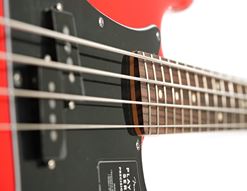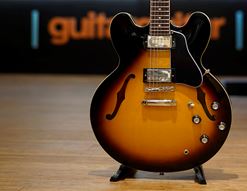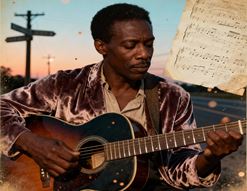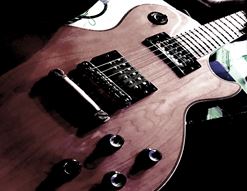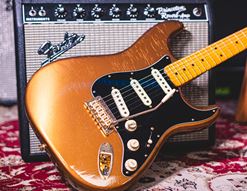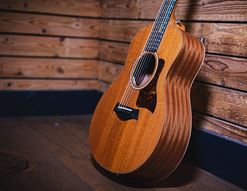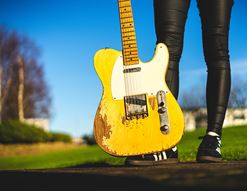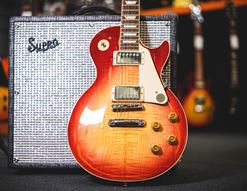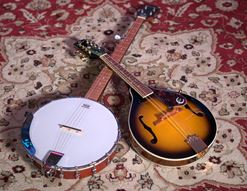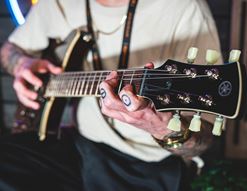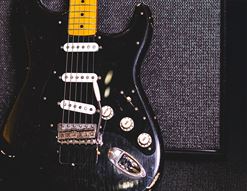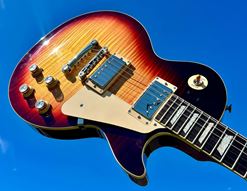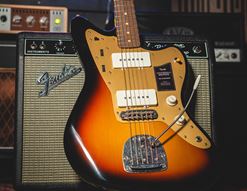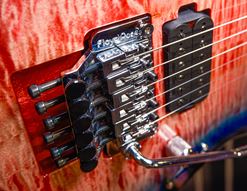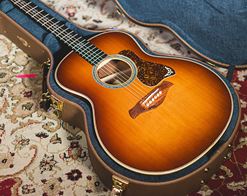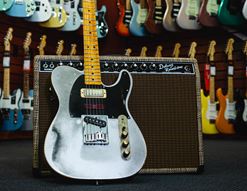Are Gibson acoustic guitars the most beautiful in the world?
I think they might be! Stretching right back into the misty Pre-War past, Gibson’s historical models have always been gorgeously eye-catching, wonderful sounding and a joy to play. No wonder they are one of the most popular acoustic guitar brands in the world!
Gibson make a wide range of different acoustic models, but today I’m only really concerning myself with the three main classics: the Hummingbird, the J-45 and the SJ-200. I want to compare these three in terms of their sound, feel, look and style. I want to consider them together, and see what makes them different.
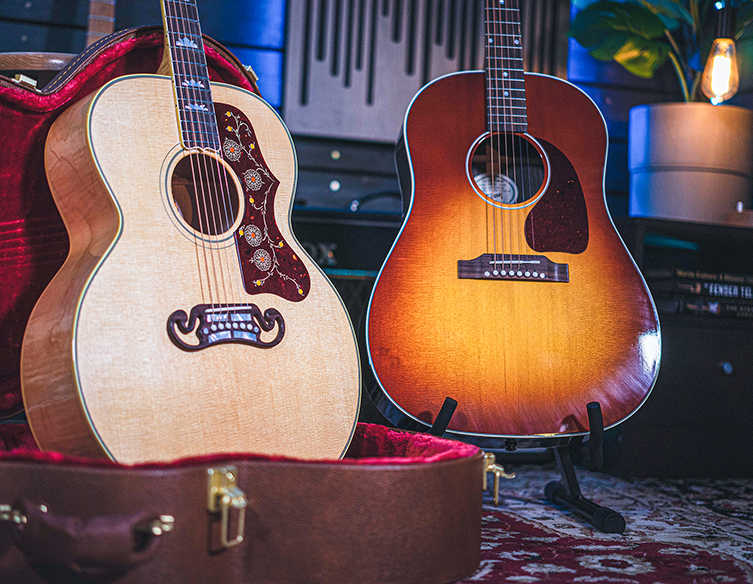
It Comes Down to 3 Gibson Acoustic Guitars
Now, we can talk all day about the various parlours, Pre-Wars and hybrid designs that Gibson have put out - and do put out - but their worldwide reputation, in my opinion, comes down to three basic shapes. I think it comes down to these:
- Square shouldered dreadnought
- Slope shouldered dreadnought
- Jumbo
Yes, I’m generalising to a large degree here, but when it comes to that Gibson sound and style, most of the iconic models fall into one of these three categories. Today, I’m going to zero into three particular models - one from each of these categories - and compare them.
I’ll also point out a few notable players for each style, and then share some thoughts about the types of players out there who might enjoy each style. That part will be pretty subjective, of course, but I feel like I have useful perspectives for you - based on my years as a performer, salesperson and writer - and they might help inform your search.
Gibson Hummingbird vs J45 vs SJ200
J-45
- Slope Shouldered Dreadnought
- Appears on more recordings than any other acoustic
- Well-balanced sound
- Visually understated
Hummingbird
- Square Shouldered Dreadnought
- Bigger sound with more bass
- Famous decorative looks
SJ-200
- Gibson’s largest acoustic
- Room-filling sound
- Percussive tone
- Beautiful looks revered by many
- More famous associations than most acoustics
Gibson J-45
- Slope shouldered dreadnought
- Appears on more recordings than any other acoustic guitar
- Well-balanced sound
- Visually understated
I’ll start with the Gibson J-45. It’s what we call a slope-shouldered dreadnought, which to you and I translates as ‘rounded’. Now, the ‘J’ does stand for ‘Jumbo’, but we don’t think of this design as such nowadays. I think it was a brand differential thing back in the day, to create distance between this and the likes of Martin guitars. This guitar is clearly a dreadnought size more than anything else!
Anyway, the J-45 (the ‘45’ bit comes from their initial price in dollars in 1942) is well-known as ‘the workhorse’ due to its unfussy looks and strong, balanced sound that sits well in most recordings and live scenarios.
The J-45 is - by Gibson standards at least - a relatively understated guitar, looks-wise. For those who don’t need the fanciness but want a real tone machine, though, the combo of spruce and mahogany hits the spot perfectly time and again. The J-45 absolutely has that defining ‘upper mid-rich’ sound that separates Gibson acoustics from other brands. Here’s how it breaks down in terms of rough specs:
- Slope Shouldered dreadnought body shape
- Spruce top
- Mahogany back and sides
- 24.75” scale length
Who Plays a Gibson J-45?
Who plays a J-45? Who doesn’t? It’s overwhelmingly popular, and fits right into any situation that calls for an acoustic guitar. Nowadays, you’ll see Kacey Musgraves and Alex Turner bringing a J-45 out on stage, and in more classic days, you could see a J-45 in the arms of Woody Guthrie, Paul Simon, Kris Kristofferson, Townes Van Sant and Lucinda Williams.
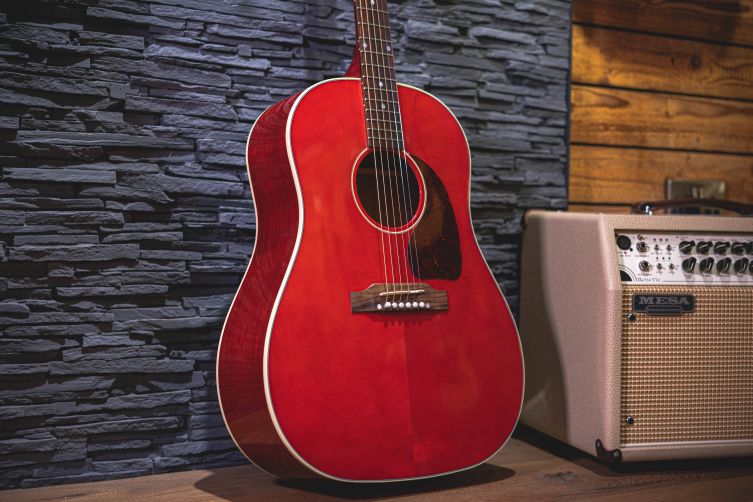
Who is the Gibson J-45 For?
Whilst all of today’s Gibsons are played by guitarists in every genre, I’d say that the J-45 is the toughest one to pin to any particular vibe. This is because it does its thing so well but so unspecifically, in terms of connotations. It’s not a fingerpicker’s guitar, though it’ll do that job brilliantly. It’s not a strummer, but it strums great! It’s not a country guitar, nor a blues one, but artists from both areas swear by the J-45.
Do you know who the J-45 is for? You. Me. Every other guitarist. It’ll work for us all. What I’ve found though, is that maybe the Hummingbird or SJ-200 is MORE ‘you’ than the J-45. Let’s keep going and see what we find.
Gibson Hummingbird
- Square shouldered dreadnought
- Bigger sound with more bass
- Famously attractive, decorative looks
The Hummingbird was Gibson’s first square-shouldered dreadnought, and easily the most famous. Debuting in 1960, most examples today keep close to the blueprint:
- Spruce top
- Mahogany back and sides
- Decorative pickguard
- Split parallelogram inlays
- 24.75” scale length
The square shouldered dreadnought body is very similar to Martin’s dreadnought (on purpose, of course) and is a little bigger than the J-45. There’s not much in it, size-wise, but the extra area afforded by the square shoulders is understood to be how the Hummingbird gets its extra volume and bass response. This wide-ranging sound perhaps makes the Hummingbird a more open and less focused sounding guitar than the J-45. It’s a matter of preference, of course, and of context.
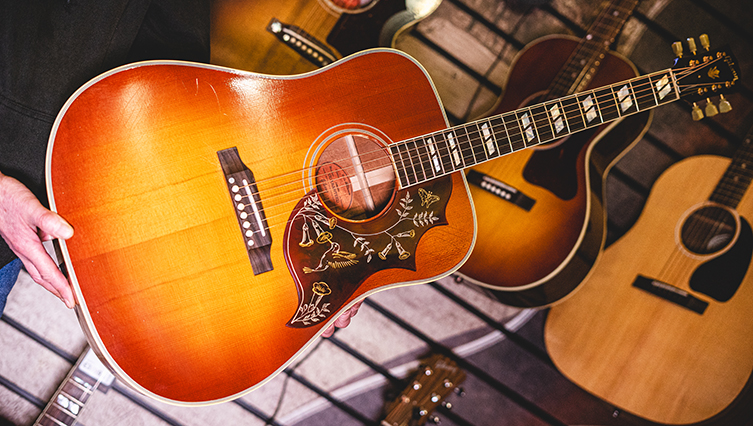
Gibson Hummingbird Artists
The Hummingbird has been seen in the arms of some very influential musicians. Keith Richards, Sheryl Crow, Tom Petty and Jesse Malin have all made great use of the design, marking it out as a great choice for songwriting rock stars who mainly enjoy a strum but need a guitar that can cover ‘the works’. They want versatility along with handsome looks for extra stage presence. For people who feel that the J-45 is just too plain Jane, the Hummingbird flies swiftly to the rescue! (Note: Jesse Malin also likes a Gibson Sheryl Crow signature model, which is a Hummingbird by any other name!)
Gibson SJ-200
- Gibson’s largest acoustic guitar
- Room-filling sound
- Percussive tone
- Beautiful looks revered by many
- Attracts a lot of ‘star power’: more famous name associations than most acoustics
The Gibson SJ-200 is the largest of today’s choices. ‘SJ’ means Super Jumbo because Gibson were already calling the J-45 a Jumbo. To most of us today, the SJ-200 is simply a Jumbo.
Now, the J-45 and Hummingbird are actually quite alike in many ways, but the SJ-200 is more different to either. Let’s delve…
- Jumbo body size - Gibson’s biggest acoustic guitar body
- Spruce top with maple back and sides (unusual)
- 25.5” scale length (also unusual)
- ‘Moustache’ bridge
- Opulent looks, including decorative flower-inlaid pickguard
They call the SJ-200 ‘the King of the Flat Tops’ (as opposed to archtop acoustics), not just because of its grand size, but also because of its loud, rich sound. That combination of spruce and maple is guaranteed to produce plenty of percussive top end tone. This works well on the SJ-200 due to its body being a big boomy, resonant box. It takes that top end and adds everything else underneath that to form a pretty huge sound!
This big, room-filling sound makes the SJ-200 a hit with singers, since they can have a complete sound with just their voice and this one guitar. The larger size does mean that some people aren’t as comfortable handling it, particularly those on the petite side of things. But, if you want the look and the sound, it’s a small price to pay!
Artists Love the Gibson SJ-200
It’s true: artists love being seen with the Gibson SJ-200 (or just 'J-200', it’s the same guitar). From Bob Dylan to Elvis to Noel Gallagher, this handsome jumbo is the one all self-respecting guitar players want to be seen with. Jimmy Page and Brian May both have signature SJ-200 models, and Sheryl Crow and Emmylou Harris are well known for playing them too.
Who is the Gibson SJ-200 For?
I picture the SJ-200 player as being a performer who likes to put on a show and make a statement. I don’t think they’ll spend too much time on introspective folksy noodling, but I do think they’ll have an appreciation for rhythm and they probably like singing. They want people to see them and know that they are a force, and this guitar choice fully supports that attitude.
How to Choose Your Gibson Acoustic Guitar
So, which of these is resonating with you so far? I tend to believe that you’ll kind of already know which one you prefer, but I’d also recommend having an objective ‘test drive’ of each one before parting with your cash. Here are some pointers for you, if you want my thoughts on it…
- Start with body size: bigger guitars sound louder but are less portable/manageable. Is this a factor for you? The J-45 is the smallest only by a tiny degree, it’s practically the same size as the Hummingbird, but they both deliver different sounds.
- Check out scale length next: did you notice that the SJ-200 has a 25.5” scale length? That’s normal for many guitars but longer than usual for Gibson. Bear this in mind as you go between models, since it’ll have a significant bearing on string tension and thus playability.
- Sound quality comes third: I know the whole point of a guitar is the sound, but if you don’t like holding the thing, or if it feels uncomfortable in your hands, then who cares what it sounds like? It’s not the guitar for you! In very basic terms, the J-45 is thick and focused; the Hummingbird is big and open; and the SJ-200 is loud and percussive. They all sound magnificent, but in slightly different ways. One will appeal to you more than the other two.
- Looks: People listen with their eyes and so do you. If looks didn’t matter then all guitars in the universe would just look like a Martin D-28. They don’t though, and you get that: that’s why you’re a Gibson fan. They are gorgeous, but which one works best for you? Which one have you been mainly eyeing up throughout this blog? That’s the one to start with.
- Look into versions of a model: once you’ve whittled it all down to a particular model, you can then start identifying variations of that model. For example, each of today’s guitars - the J-45, Hummingbird and SJ-200 - is available in a Gibson Original model, a Standard and a new Special version. Each has their own features, omissions and relative price points, so dive into that once you’ve locked in on a style.
Consider Epiphone
Now, this guide is for the big three in Gibson acoustics, but I feel it would be remiss of me not to at least mention Epiphone now. I realise that if your heart’s desire is a USA-made Gibson then nothing else will do. I fully get it, and I think along the same lines myself if I’m being perfectly honest with you.
That said, Epiphone are making better guitars than ever before, and are inching ever closer to some Gibson originals in style at least. They aren’t the same - people who say they are are mistaken, I’m afraid - but the gap in both quality is much narrower than it was even a few years ago.
I’d recommend the Epiphone Inspired by Gibson range to you without hesitation. I’ve been genuinely impressed by their models, particularly the Epiphone Inspired by Gibson SJ-200. For semi-pro players looking to make a statement on a stage and still enjoy the guitar from a feel and sound point of view, well, these are great and cost a whole lot less than their OG American cousins!
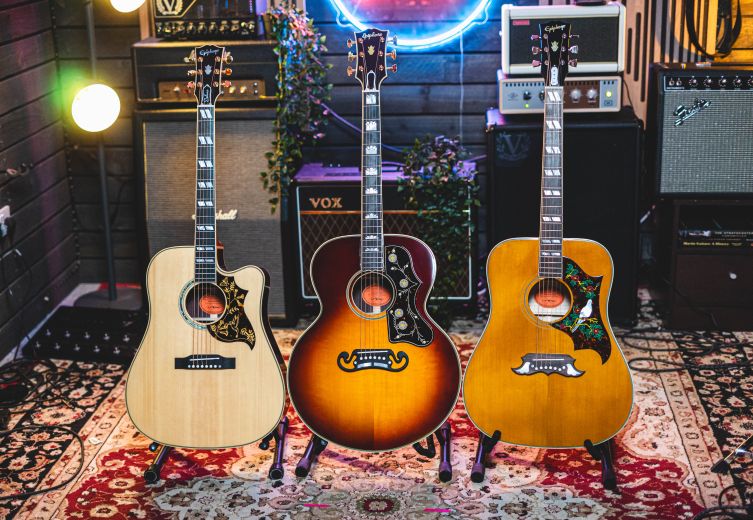
There is No Wrong Choice
Here’s the final thought. You’re looking to choose a new Gibson acoustic guitar. You can’t actually get this wrong. This whole endeavour, it’s impossible to fail here, ok? Picking out a guitar is a treat, a pleasure and an all-consuming thing, right up until you lay out your cash and take your final choice home. But that final choice can never be a ‘bad’ one when we are dealing with instruments of this calibre. One choice may be more or less right for you - and hopefully this blog has helped clarify that for you - but if you are choosing a Gibson acoustic guitar, then - with no sense of hyperbole or salesmanship attached - you simply cannot make a wrong choice.

